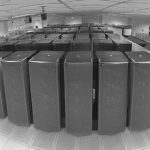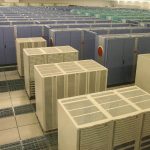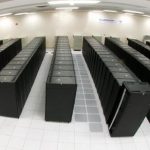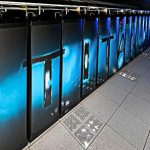Supercomputers


Lawrence Livermore National Laboratory
Supercomputer speed records: World’s fastest machines of the past 15 years
By Nick Heath From Tech Republic
Supercomputers are perhaps the pinnacle of computing – machines capable of doing in seconds work that would take a PC years to carry out.
As with any computer, the performance of these warehouse-sized installations continues to increase exponentially, to the point where modern supercomputers are able to analyse quantities of data that would have been unthinkable at the turn of the century.
Over the following pages you’ll see the most powerful machines in the world from the past 15 years and the performance records they’ve broken along the way.
Image: Corbis
June 2001 – June 2002: ASCI White
The ASCI White supercomputer was used by Lawrence Livermore National Laboratory to help maintain the US nuclear weapons stockpile – carrying out testing to ensure warhead safety and simulating explosions.
Packing 8,192 IBM Power3 processor cores and 160 terabytes (TB) of disc storage, the IBM machine had a theoretical peak performance of 12.288 TFlop/s (trillion floating point operations per second). ASCI White ran the AIX OS and shuttled data between its processors using SP Switch interconnects.
Image: Don Gonzalez / Lawrence Livermore National Laboratory
June 2002 – November 2004: Earth-Simulator
Ruling the roost for several years, NEC’s Earth Simulator machine was significantly faster than the competition. Tasked with nothing less than running a virtual Earth, the system was used by the Japanese government to simulate natural disasters and develop countermeasures.
Sitting in a three-story building, Earth Simulator used 5,120 custom-made 1GHz processor cores, had 10TB of memory, 640TB of disc and 1.5 petabytes (PB) of supplemental storage. The machine’s peak performance stood at 40.96 TFlop/s, it ran the Super-UX OS and relied on multi-stage crossbar interconnects.
Image: Manatee_tw under GNU Free Documentation License.
November 2004 – June 2008: Blue Gene/L
The IBM Blue Gene/L system originated from a program to make supercomputers capable of studying how proteins are created inside the human body, which in turn could help develop new treatments for disease. Blue Gene/L was so powerful that it was deemed the fastest supercomputer in the world before it was even complete, with a half-finished version claiming the performance crown in November 2004.
Although several versions of Blue Gene/L were built, the most powerful machine, and the one that claimed the top spot, was used by Lawrence Livermore National Laboratory (LLNL). Starting out with a peak performance of 91.75 TFlop/s, the LLNL supercomputer was upgraded several times. At its height, the machine sported 212,992 PowerPC 440 processor cores running at 700MHz and 73,728 GB (~74TB) of memory. This version had a peak performance of 596.378 TFlop/s and drew 2,329kW of power. It ran the CNK/SLES 9 OS and used proprietary interconnects.
Image: IBM
June 2008 – November 2009: Roadrunner
Built using an advanced version of the processor found inside the PlayStation 3, Roadrunner was yet another immensely powerful machine devoted to testing the US nuclear arsenal.
Initially, Roadrunner was spread over 278 refrigerator-sized cabinets at at the US Department of Energy’s Los Alamos National Laboratory. Over time the IBM machine was upgraded, with its peak performance increasing from 1,375.78 TFlop/s to 1,456.7 TFlop/s in 2009. The 2009 machine ran 129,600 PowerXCell 8i processing cores, each clocked at 3.2GHz and drew 2,483kW of power. The system ran the Red Hat Enterprise Linux and Fedora operating systems and used Infiniband interconnects.
Image: Los Alamos National Laboratory
November 2009 – November 2010: Jaguar
Something of a jack of all trades, the Jaguar supercomputer is tasked with tackling the thorniest problems facing civilization. One day the machine, based at Oak Ridge National Laboratory in the US, could be testing new materials, the next doing climate modelling.
During its time at the top, the Cray XK6 machine sported 298,592 AMD Opteron 6274 processor cores, clocked at 2.2GHz each, and 598,016 GB (~598TB) of memory. With a theoretical peak performance of 2,627.61 TFlop/s, the machine ran a Cray Linux-based OS and used Cray Gemini interconnects. It drew 5,142kW of power.
Image: National Center for Computational Sciences, Oak Ridge National Laboratory
November 2010 – June 2011: Tianhe-1A
The Tianhe was significant for two reasons, it saw the supercomputing crown shift from the US to China and its design was significantly different to previous top machines. Based at Tianjin, near Beijing, the machine crunches data related to oil exploration and aircraft design.
By making heavy use of graphics processing units (GPUs) — commonly used for 3D video games — alongside central processing units (CPUs), the machine was able to significantly improve performance without ramping up power use, with its overall draw standing at 4,040kW.
In 2010, the Tianhe-1A relied on 7,168 Nvidia Tesla M2050 GPUs and 14,336 Intel Xeon X5670 CPUs, as well as 2,048 NUDT FT1000 heterogeneous processors. Its peak performance stood at 4,701 TFlop/s and it ran a Linux-based OS and used proprietary interconnects.
Image: National Supercomputing Center in Tianjin
June 2011 – June 2012: K computer
Capable of crunching more than 8 quadrillion calculations per second at launch, the K computer saw Japan reclaim the supercomputing title for the first time since 2004. Based in Kobe’s RIKEN Advanced Institute for Computational Science, the K computer, is attempting to crack some of science’s toughest problems, engaged in everything from disaster prevention to medical research.
Unlike the Tianhe-1A, the Fujitsu-designed machine didn’t use GPUs but instead packed in 705,024 SPARC64 VIIIfx processor cores, each rated at 2GHz, and 1,410,048 GB (~1.4PB) of memory. Its peak performance in 2011 reached 11,280.4 TFlop/s and it drew 12,659.89 kW of power. The machine uses custom interconnects and runs a Linux-based OS.
Image: Riken
June 2012 – November 2012: Sequoia
Sequoia is a computer powerful enough to model some of the largest and most complex processes that exist, from an approximation of the universe to the beating of the human heart. Based at the US’ Lawrence Livermore National Laboratory the machine was not only the most powerful but one of the most efficient at the time.
Sequoia, an IBM Blue Gene/Q system, achieved a peak performance of 20,132.7 TFlop/s using 1,572,864 Power BQC cores, rated at 1.6GHz. The machine relied on 1,572,864 GB (~1.5PB) of memory. It uses the CNK and Red Hat Enterprise Linux operating systems and custom interconnects.
Image: Bob Hirschfeld / LLNL
November 2012 – June 2013: Titan
Able to handle more than 20 quadrillion calculations per second, the Titan supercomputer is tasked with helping researchers at the US Oak Ridge National Laboratory probe climate change, alternate fuel sources and other global challenges.
The Cray XK7 machine relies on a mix of processors, utilising 560,640 cores, split between AMD Opteron 6274 processors, clocked at 2.2GHz, and NVIDIA K20x accelerators. Its peak performance at the time was 27,112.5 TFlop/s and it had 710,144GB of memory. The Titan runs a Linux-based OS made by Cray and uses the Cray Gemini interconnects. It draws 8,209 kW of power.
Image: Oak Ridge National Laboratory
June 2013 – Today: Tianhe-2
With the Tianhe-2, a machine capable of performing more than 33 quadrillion calculations per second at launch, China once again took the top spot from the US and, so far, has managed to hold onto it. Deployed at the National Supercomputer Center in Guangzho, it is the successor to the Tianhe-1.
The Tianhe-2, otherwise known as the Milky Way 2, has 16,000 nodes, each with two Intel Xeon E5 Ivy Bridge processors and three Xeon Phi 31SP co-processors, for a combined total of 3,120,000 computing cores. This architecture allows it to carry out a massive number of operations in parallel, although reportedly makes it more difficult to write code for. Combined with 1,024,000 GB (~1PB) of memory, the machine’s theoretical peak performance is 54,902.4 TFlop/s. Its power draw is a whopping 17,808 kW and it runs Kylin Linux and uses TH Express-2 interconnects.
Image: Jack Dongarra
For more on this story go to: http://www.techrepublic.com/pictures/supercomputer-history-the-worlds-fastest-machines-over-the-years/?ftag=TREe09998f&bhid=22414566808023710814878762937500
















